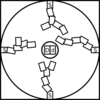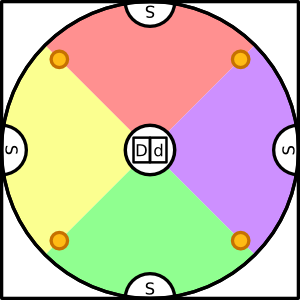After some of the discussion regarding omnidirectional movement in http://www.bgdf.com/node/3755, this game occurred to me; I thought I'd toss it out there to get some feedback.
Untitled Game
for 4 players
The Board
The board consists of a large circle marking the boundary of the board, a small circle in the middle (where the draw pile will be kept), and four starter spaces at the boundary of the circle where the four players will begin.

The Cards
There are 90 cards, numbered 1-15. Some of them may also have special properties; more on that below. Each card has its number written on each of its four corners.
Each player starts with a hand of 6 cards.
Layout
During the course of the game players will play cards to build sets of cards connected to each other by overlapping. The set of all cards connected this way to your starter space is called your tree. Player's trees can never be connected to one another (though they may contain loops back to themselves). Cards on the board that are not connected to any player's tree are collectively called dead wood.

Card ranking
The cards are ranked circularly so that each number beats 7 other numbers and is beaten by 7 numbers. In particular, a card numbered X beats a card numbered Y if X-Y <=7 or Y-X > 7. Thus, 8 beats 1-7 and loses to 9-15, but 2, for example, loses to 3-9 but beats 10-15 and 1. To avoid making players do math all the time the cards might show on them a list of which numbers they beat and which they do not.
Gameplay
You take your turn by taking a card from your hand and placing it anywhere on the board, in any orientation, subject to the following four rules:
- A card you place MUST overlap a card in your tree (so that every card you play expands your tree)
- Every card on the board must have at least one of the numbers in its corner fully visible (so any play that would obscure the only fully visible corner of a card is illegal)
- A card can only be played if its number beats the numbers on EVERY card it overlaps
- Cards must be entirely inside the outer circle of the board, and entirely outside the inner circle.
After you play a card, you draw a new card to replace it, taking the top card of the draw pile OR the discard pile.
Attacking
When you play a card that overlaps a card not in your tree, one of two things happens:
- If the card was dead wood, then you absorb it - it and all cards connected to it become part of your tree.
- If the card was part of somebody else's tree, it is removed from the board and put on top of the discard pile.

Winning
You win if your tree ever contains a complete loop around the center circle.

Variations
Possible variations I'm considering include:
- Having some cards have special properties, e.g. "this card destroys dead wood instead of absorbing it", or "this card can only be destroyed by even numbers".
- Having other regions on the board with special properties, e.g. "If you play a card overlapping this region, take another turn".
Thoughts?
My biggest worry is that it will be too hard to keep the cards from shifting, especially when for example a card that is partly underneath several other cards gets taken. My second biggest worry is that the game would go in circles forever, with nobody ever finishing a full loop because the other players keep attacking them.








Regarding the attack cycle
Attacking isn't as easy as you describe - you can't place your card unless it beats EVERY card underneath, which in an attack means at least the trunk card off of which you're building and the card to be attacked. For example, if you have an 8, and I have a 1 right next to it, neither of us can attack the other because there are no cards at all that beat both 8 and 1. More usefully, if I have a 9 I might put a 2 in range of your 8 because I know that while it's very unlikely that you'll be able to attack me, I'll definitely be able to attack you.
I'm not sure that "ganging up on the leader" will be an issue - as soon as you attack the leader near the root of one of his card tendrils, he loses control of the entire tendril; any other player can then claim the tendril and immediately become the new leader. I haven't had a chance to build a prototype of this and try it out, but I think in the end game a couple of long segments will change hands continuously until somebody will get an opportunity to do more than one.
Regarding playing anywhere
I didn't want players to be able to attack each other without reaching them, since otherwise attacking becomes far too easy. Likewise, playing dead wood could be too powerful - in the example I gave above, I might put a dead 1 right next to your eight to stop you in your tracks.
Also, if there are special spaces worth capturing, it would silly to let people cover them from a distance.
Regarding bumping the cards
I was pretty attached to the freeform movement idea, but I can see why it's almost certainly going to break down. I've played around with a couple of ideas - heavier cards, some sort of velcro board, etc. - but I can only see one way to make it work out, which is to make it a computer game; but that may be less interesting (I might hack it together later just to see :-) ).
Even if it's going to be more structured it'll be tricky because I'll still have cases where the player needs to remove a card that is underneath several others, and it'll be hard to see what all cards are in a square if several pile over the same cell. I'll have to think about this more.
Regarding representing the attack cycle
Maybe instead of 1-15, I should have 16 cards, where each beats the 7 above it, loses to the 7 below it, and ties with itself or with the card opposite it... Then this can be represented by replacing each number with itself modulo 4 and grouping them into four sets, each of which beats another set.
Call the sets A, B, C, D, so that the 16 cards are A1, ..., A4, B1, ... , D3, D4.
Then set it so that A always beats B, B always beats C, C beats D, and D beats A; within a group, higher numbers beat lower numbers; within two opposing groups (e.g. A vs C), lower numbers beat higher numbers.
Then replace the letters with something slightly more intuitive... I'll work on that.
Regarding everything
Thanks for all your feedback, both of you!